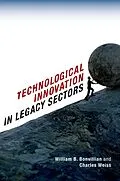The American economy faces two deep problems: expanding innovation and raising the rate of quality job creation. Both have roots in a neglected problem: the resistance of Legacy economic sectors to innovation. While the U.S. has focused its policies on breakthrough innovations to create new economic frontiers like information technology and biotechnology, most of its economy is locked into Legacy sectors defended by technological/ economic/ political/ social paradigms that block competition from disruptive innovations that could challenge their models. Americans like to build technology "covered wagons" and take them "out west" to open new innovation frontiers; we don't head our wagons "back east" to bring innovation to our Legacy sectors. By failing to do so, the economy misses a major opportunity for innovation, which is the bedrock of U.S. competitiveness and its standard of living. Technological Innovation in Legacy Sectors uses a new, unifying conceptual framework to identify the shared features underlying structural obstacles to innovation in major Legacy sectors: energy, air and auto transport, the electric power grid, buildings, manufacturing, agriculture, health care delivery and higher education, and develops approaches to understand and transform them. It finds both strengths and obstacles to innovation in the national innovation environments - a new concept that combines the innovation system and the broader innovation context - for a group of Asian and European economies. Manufacturing is a major Legacy sector that presents a particular challenge because it is a critical stage in the innovation process. By increasingly offshoring production, the U.S. is losing important parts of its innovation capacity. "Innovate here, produce here," where the U.S. took all the gains of its strong innovation system at every stage, is being replaced by "innovate here, produce there," which threatens to lead to "produce there, innovate there." To bring innovation to Legacy sectors, authors William Bonvillian and Charles Weiss recommend that policymakers focus on all stages of innovation from research through implementation. They should fill institutional gaps in the innovation system and take measures to address structural obstacles to needed disruptive innovations. In the specific case of advanced manufacturing, the production ecosystem can be recreated to reverse "jobless innovation" and add manufacturing-led innovation to the U.S.'s still-strong, research-oriented innovation system.
Autorentext
William B. Bonvillian is Director of the MIT Washington Office. Previously, he served as a senior advisor in the U.S. Senate. He has taught technology policy at Georgetown, Johns Hopkins, and MIT. He has served on a National Academies' Board and five Committees, received the IEEE Distinguished Public Service Award and was elected a Fellow of the American Association for the Advancement of Science. He is a frequent speaker on science and technology policy topics. Early in his career, he served as a Deputy Assistant Secretary of Transportation, and was a partner at a major national law firm. Charles Weiss was Distinguished Professor of Science, Technology and International Affairs (STIA) at the Georgetown University School of Foreign Service until his retirement in 2014. He was STIA director from 1997-2006 and the first Science and Technology Adviser to the World Bank. He is a Fellow of the American Association for the Advancement of Science and a Member of the Council on Foreign Relations. He has a B.A. in chemistry and physics, summa cum laude, and a Ph.D. in chemical physics and biochemistry, both from Harvard University.
Inhalt
Chapter 1 - The Root Problems: Expanding Innovation and Creating Jobs Chapter 2 - The Legacy Sector Challenge Chapter 3 - Paradigms as Obstacles to Innovation in Legacy Sectors Chapter 4 - Production Matters Chapter 5 - What's Blocking Innovation in Legacy Sectors? Chapter 6 - Six U.S. Legacy Sectors: Energy, the Grid, Buildings, Air and Auto Transport and Manufacturing Chapter 7 - Applying the Legacy Framework to Service Sectors: Higher Education and Health Care Delivery Chapter 8 - Innovating in the Defense Sector Chapter 9 - Enabling and Disabling National Innovation Environments in Europe, China, and India Chapter 10 - Exporting Inappropriate Paradigms in Agriculture and Energy Chapter 11 - Innovation Dynamics, Change Agents, and Innovation Organization Chapter 12 - Launching Innovation into Legacy Sectors Chapter 13 - Case Study: Applying the Policy Framework to Advanced Manufacturing Chapter 14 - Conclusions: Turning Covered Wagons East
